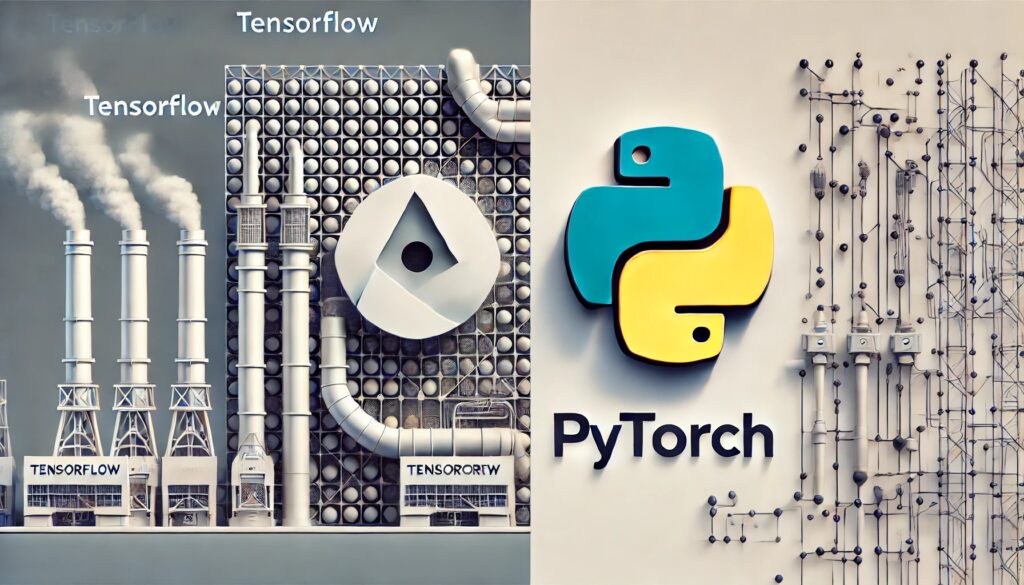
Both TensorFlow and PyTorch are premier deep learning frameworks extensively used for building and training neural networks. Each framework has unique advantages, tailored to different users and projects. Here’s a comprehensive comparison to help beginners make an informed choice between TensorFlow and PyTorch.
Ease of Use and Learning Curve
TensorFlow:
- Initial Complexity: Historically, TensorFlow was notorious for its steep learning curve due to static computation graphs.
- TensorFlow 2.x: This version introduced eager execution by default, significantly improving its user-friendliness and intuitiveness.
- Documentation and Tutorials: Extensive documentation and a wealth of tutorials make learning easier for beginners.
- Google Support: Strong backing from Google ensures integration of the latest research and continuous improvement of the framework.
PyTorch:
- Simplicity and Intuitiveness: PyTorch is celebrated for its simplicity and ease of use, making it ideal for beginners.
- Dynamic Computation Graph: Uses a define-by-run approach, which is more intuitive and easier to debug compared to static computation graphs.
- Community Support: A robust community provides abundant tutorials and examples, fostering a supportive learning environment.
- Academic Preference: Its flexibility and ease of experimentation make it the preferred choice in academia.
Performance and Flexibility
TensorFlow:
- Production Optimization: Optimized for production use, especially in large-scale deployments.
- Deployment Tools: TensorFlow Serving and TensorFlow Lite offer robust solutions for deploying models on servers and mobile devices.
- Complete ML Pipeline: TensorFlow Extended (TFX) provides a comprehensive production ML pipeline.
PyTorch:
- Research Flexibility: Highly flexible, making it well-suited for research and development.
- JIT Compiler: The PyTorch JIT (Just-In-Time) compiler can optimize models for production, though it’s relatively new compared to TensorFlow’s ecosystem.
- TorchServe: Provides model serving capabilities, although it’s not as mature as TensorFlow Serving.
Community and Ecosystem
TensorFlow:
- Extensive Ecosystem: A larger user base and more extensive ecosystem offer more resources.
- Pre-trained Models and Datasets: TensorFlow Hub, TensorFlow Model Garden, and TensorFlow Datasets provide pre-trained models and datasets for quick experimentation.
- Google Integration: Strong integration with Google services and platforms like Google Cloud AI enhances its utility.
PyTorch:
- Growing Community: Rapidly growing, particularly strong in academic research.
- Specialized Tools: PyTorch Hub and PyTorch Geometric offer specialized models and tools.
- Facebook Ecosystem: Strong integration with Facebook’s ecosystem, including ONNX (Open Neural Network Exchange) for interoperability.
Tools and Libraries
TensorFlow:
- Visualization and Debugging: TensorBoard provides powerful tools for visualization and debugging.
- Browser-Based Models: TensorFlow.js allows running models directly in the browser.
- Probabilistic Models: TensorFlow Probability supports probabilistic modeling.
- High-Level API: Keras, now tightly integrated with TensorFlow, offers a high-level API for building models easily.
PyTorch:
- Visualization Tools: Visdom and TensorBoardX provide visualization capabilities (TensorBoard support is also available).
- Research to Production: TorchScript helps transition models from research to production.
- Simplified Training: PyTorch Lightning and Fastai offer high-level APIs that simplify training workflows.
- Reinforcement Learning: Strong support for reinforcement learning with libraries like Stable Baselines3.
Industry Adoption and Job Market
TensorFlow:
- Industry-Wide Adoption: Widely adopted across various industries, with many large companies using it in production.
- Job Market: Historically higher number of job postings, although the gap with PyTorch is narrowing.
PyTorch:
- Academic and Industry Adoption: Increasingly adopted by both academia and industry.
- Cutting-Edge Research: Preferred by researchers, leading to faster integration of cutting-edge research into production.
- Growing Job Market: Rising presence in the job market, particularly in roles focused on research and development.
Recommendations for Beginners
Choose TensorFlow if:
- You aim to deploy models in production at scale.
- You prefer a more extensive ecosystem with robust deployment tools.
- You’re interested in leveraging Google’s ecosystem and cloud services.
Choose PyTorch if:
- You are just starting and want an easy-to-understand and flexible framework.
- You are involved in research or academic work.
- You prefer a dynamic computation graph for easier debugging and experimentation.
Conclusion
Both TensorFlow and PyTorch are powerful frameworks, and the choice largely depends on your specific needs and preferences. As a beginner, PyTorch might offer a gentler learning curve and a more intuitive experience. However, TensorFlow’s robust production tools and wide industry adoption make it a strong choice for scalable and production-ready applications.
Related Resources
- TensorFlow Official Documentation
- PyTorch Official Documentation
- TensorFlow vs. PyTorch: A Comprehensive Comparison
By evaluating your goals and the type of projects you plan to undertake, you can make an informed decision and embark on your deep learning journey with confidence.
Master PyTorch: Step-by-Step Guide for Beginners
TensorFlow: The Computer Vision Powerhouse!